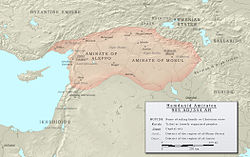
Back Hamdanidiese dinastie Afrikaans الدولة الحمدانية Arabic الدوله الحمدانيه ARZ Həmdanilər Azerbaijani حمدانیلر سولالهسی AZB Хамданиди Bulgarian Hamdànides Catalan دەوڵەتی حەمدانی CKB Hamdaniden German Χαμδανίδες Greek
You can help expand this article with text translated from the corresponding article in Arabic. (July 2013) Click [show] for important translation instructions.
|
This article needs additional citations for verification. (July 2016) |
Hamdanid Dynasty الحمدانيون al-Hamdaniyyun | |||||||||||
|---|---|---|---|---|---|---|---|---|---|---|---|
| 890–1004 | |||||||||||
 Hamdanid territory in 955 during the rule of Sayf al-Dawla | |||||||||||
| Capital | Mardin (892–895) Mosul (905–990) (in Iraq) Aleppo (944–1002) (in Syria) | ||||||||||
| Common languages | |||||||||||
| Religion | Shia Islam (official) Christianity | ||||||||||
| Government | Hereditary monarchy | ||||||||||
| Emir | |||||||||||
| Historical era | Middle Ages | ||||||||||
• Established | 890 | ||||||||||
• Husayn ibn Hamdan establishes himself as leader of Al-Jazira for the Abbasids. | 895 | ||||||||||
• Sayf al-Dawla establishes himself in Aleppo after successfully countering the Ikhshidids of Egypt. | 944 | ||||||||||
• Disestablished | 1004 | ||||||||||
| |||||||||||
| Historical Arab states and dynasties |
|---|
 |

The Hamdanid dynasty (Arabic: الحمدانيون, romanized: al-Ḥamdāniyyūn) was a Shia Muslim Arab [1][2][3] dynasty that ruled modern day Northern Mesopotamia and Syria (890–1004). They descended from the ancient Banu Taghlib tribe of Mesopotamia and Arabia.
- ^ Corbin 2014, p. 158.
- ^ Canard 1971, p. 126.
- ^ Bosworth 1996, p. 85.